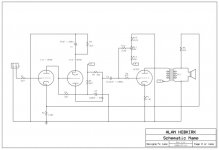Frank Berry said:And that's where the NFB is introduced. Bypass cap will stop the NFB cold.
Huh? The GNFB is clearly to the input tube cathode.
Frank Berry said:Sorry. I missed the resistor on the cathode of the output tube.
My mistake. Oh well. I've been up too long. I'm tired and not as alert as I should be.
Same this side when I first drew the schematic. Late at night, full of drugs (from the dentist!) and tired plus being shocked by the murder of a friend...
What a day it has been... yesterday that is.
D
Sorry to hear about your friend, that is shocking.
I think waht people are getting at is the strange way the schematic has been set out. It's unconventional, to say the least. Try looking at other schematics to get the idea of how to represent the circuit in a way people are used to seeing.
Don't forget, if you change from grid (a.k.a. fixed) bias to cathode bias, you will effectively lose a portion of your B+ (H.T.) voltage. I don't know what your cathode bias voltage would be but it will be built up across the cathode resistor, reducing your available plate-cathode voltage by the same amount. So, you may have to increae your B+ to compensate or you may lose power.
I think waht people are getting at is the strange way the schematic has been set out. It's unconventional, to say the least. Try looking at other schematics to get the idea of how to represent the circuit in a way people are used to seeing.
Don't forget, if you change from grid (a.k.a. fixed) bias to cathode bias, you will effectively lose a portion of your B+ (H.T.) voltage. I don't know what your cathode bias voltage would be but it will be built up across the cathode resistor, reducing your available plate-cathode voltage by the same amount. So, you may have to increae your B+ to compensate or you may lose power.
- Status
- This old topic is closed. If you want to reopen this topic, contact a moderator using the "Report Post" button.
